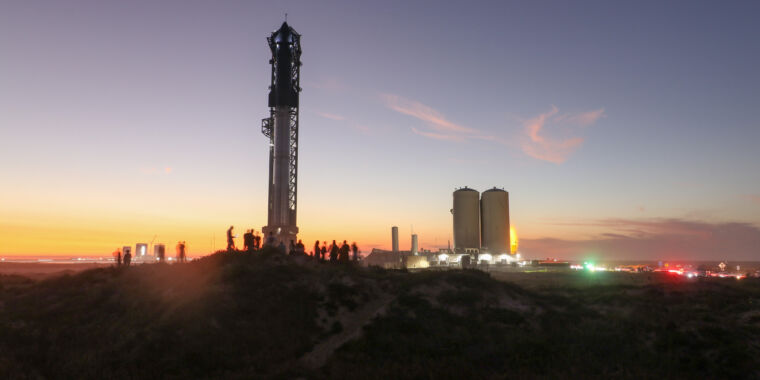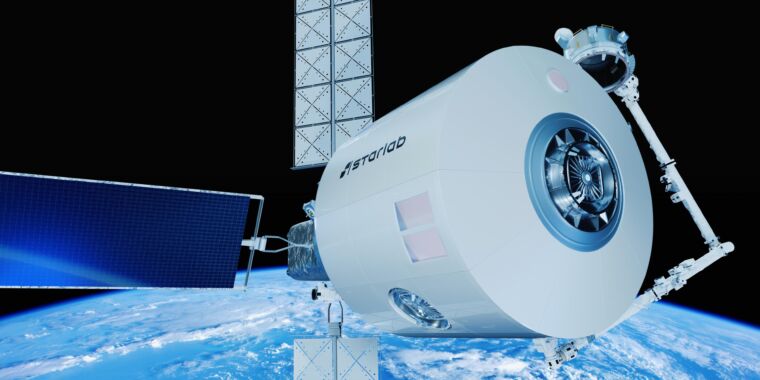-
SpaceX fans turned out at Starbase, the company’s sprawling test facility in South Texas, on the eve of the second full-scale test flight of the Starship rocket.
Stephen Clark/Ars Technica -
The nearly Super Heavy booster and Starship rocket reach toward the heavens Friday night, about 12 hours before their scheduled launch.
Stephen Clark/Ars Technica -
SpaceX’s Starship launch pad includes a support tower, an elevated launch mount, and a tank farm for methane, liquid oxygen, and water.
Stephen Clark/Ars Technica -
The fully integrated Super Heavy booster stands approximately 397 feet (121 meters) tall and measures about 30 feet (9 meters) in diameter. That is larger than the fuselage of the Airbus A380, the world’s largest commercial passenger airplane.
Stephen Clark/Ars Technica -
The Moon passes behind the top of Starship.
Stephen Clark/Ars Technica
BOCA CHICA BEACH, Texas—Early Saturday morning, SpaceX will load more than 10 million pounds of super-cold methane and liquid oxygen into the propellant tanks inside the company’s second flight-ready Super Heavy booster and Starship rocket.
Then, if all goes according to plan, 33 Raptor engines will light at 7 am CST (13:00 UTC) to propel this gigantic rocket into the sky over Boca Chica Beach, a remote stretch of South Texas shoreline a couple of miles north of the US-Mexico border. SpaceX will live stream the event on X.
Space fans got what they hope will be their last look at this particular rocket Friday night, hours before law enforcement closed off public access to the launch site. One of the neat things about SpaceX’s privately-owned South Texas launch site, named Starbase, is the public can approach within a few hundred feet of the rocket. The surrounding mud flats, dunes, and beach are all public land.
At government launch sites, such as Cape Canaveral, Florida, public access is generally restricted to guided tours. Even then, the closest most people can get to an active launch pad is about a mile, and much farther than that on launch days.
SpaceX delayed the Starship test flight from Friday to replace actuators on grid fins positioned near the top of the rocket’s first stage. Ground teams removed the upper stage from the rocket Thursday to complete the repairs, then reinstalled the upper stage Friday morning to continue with launch preparations.
The test flight on tap Saturday, if fully successful, will put SpaceX on a path toward additional demonstrations, and perhaps the first operational Starship flights to carry Starlink Internet satellites into orbit. Eventually, SpaceX wants Starship to be the next-generation vehicle to replace and expand the capacity offered by the company’s existing Falcon 9 rocket and Dragon spacecraft.
On Saturday, SpaceX’s launch team will begin loading propellants into the Super Heavy booster and Starship upper stage a little more than 90 minutes before liftoff time. Thermal conditioning of the rocket’s Raptor engines will start around 20 minutes prior to launch. In the final 10 seconds of the countdown, several hundred thousand gallons of water will flow through a deluge system to dampen the energy from the nearly simultaneous ignition of 33 Raptor engines at the bottom of the rocket.
If you’re a space enthusiast, that’s when the real fun begins. Here are five things to watch for on SpaceX’s second full-scale Starship test flight.
1. How will the launch pad hold up?
When the first Starship rocket launched April 20, it made a big mess. The blast from the Super Heavy booster’s Raptor engines blew a hole in the concrete beneath the pedestal the rocket sits before launch. Massive chunks of concrete were strewn across hundreds of acres around the launch pad, denting tanks and carving craters in the surrounding mud flats. Clouds of dust and sand fell on communities several miles away.
This is something SpaceX doesn’t want to repeat with the second test flight, so engineers installed a water deluge system at the pad to protect it from similar damage again. In the final seconds of the countdown, the deluge system will release up to 358,000 gallons of fresh water through channels built into a steel plate installed underneath the pad’s circular launch mount. The fountain-like flow of water is supposed to absorb the heat and acoustic energy from the Super Heavy engines.
Other launch pads, including SpaceX’s own launch facilities for the Falcon 9 rocket, use similar water deluge systems.
SpaceX tested the water deluge system several times since April, including on a pair of hold-down engine tests with the Super Heavy booster in August. The launch pad held up fine during those hot-fire tests, and we’ll soon know if the deluge system does the job during a real launch.
2. Will the Raptor engines work better this time?
At least five of the 33 Raptor engines failed on the Super Heavy booster when it flew for the first time in April. SpaceX will try to improve on that with the second test flight of the Super Heavy-Starship rocket.
These engines each generate a half-million pounds of thrust, for a total of nearly 17 million pounds of thrust while the Super Heavy booster powers the rocket for the first two-and-a-half minutes of the flight. This is more than twice the thrust of the Saturn V rocket used for the Apollo Moon missions. SpaceX can afford to lose a handful of engines without any catastrophic effects on the test flight, but it would be nice if the rocket lost none.
In April, propellant leaks and fires in the booster’s engine compartment severed connection with the rocket’s primary flight computer, and the vehicle lost control a little more than two minutes into the flight. Shortly thereafter, a self-destruct mechanism activated to blow up the rocket.
For the second test flight, SpaceX technicians tightened bolts in fuel manifold connections on the Raptor engines to reduce the risk of leaks. They’ve also beefed up shielding between the engines to protect adjacent Raptors from an explosion on a neighboring engine. On future launches, Raptor engines will have redesigned fuel manifolds to fully address the part that is prone to leaks.
“We do anticipate the Raptor engines will perform better for this test,” said Lisa Watson-Morgan, manager of NASA’s Human Landing System program, which oversees a SpaceX contract to develop a human-rated lunar lander based on the Starship design. “By the time of the Human Landing System Starship, we will be on a much later generation of Raptor, thereby having the predictability of the engines that is required for human-rating of the Starship itself.”
The Super Heavy booster’s steering system also has an upgrade debuting on the second test flight. This is a switch from a hydraulic thrust vector control mechanism to an electric one to gimbal, or pivot, thrust from the cluster of 13 Raptor engines at the center of the Super Heavy booster. The outer ring of 20 engines do not gimbal.
3. How will hot staging work?
Then, at 2 minutes and 41 seconds into the flight, there’s another big moment. This is when the Super Heavy booster will switch off its engines and release from the Starship upper stage to climbing into space.
The rocket flown on the April 20 test flight didn’t make it this far before tumbling out of control. Assuming the rocket is still flying steady at this point, the Super Heavy booster will shut down most of its engines to start the stage separation sequence, followed by the physical disconnection of the stages at the exact moment the Raptor engines ignite on the upper stage. This “hot staging” technique, though novel for SpaceX, has been used on a number of Russian rockets for decades.
Typically, rockets switch off their booster engines for a few seconds before jettisoning the first stage, and then lighting the upper stage a moment later. The upshot of the change is it increases the Starship’s payload lift capability, which already amounted to more than 100 metric tons to low Earth orbit. But it means engineers had to add shielding to the top of the stainless steel booster, which SpaceX wants to recover and reuse numerous times.
One of the design changes required to implement hot staging is a new 6-foot extension to the top of the Super Heavy booster with vents to allow super-hot gas from the upper stage engines to safely flow out of the rocket’s structure “and not just blow itself up,” Musk said earlier this year. “This is the most risky thing, I think, for the next flight.”
“I think the probability of this next flight working, getting to orbit, is much higher than the last one,” Musk continued. “Maybe it’s like 60 percent. It depends on how well we do at stage separation.”
4. Can Starship fly in space?
SpaceX tested five Starship prototypes in 2020 and 2021 on high-altitude flights within the atmosphere, for the purpose of wringing out the company’s concept on how to land the vehicle. These tests all ended in explosions until the last one on May 5, 2021, when a full-scale Starship upper stage safely landed after flying to an altitude of around 33,000 feet (10 kilometers).
These were dramatic events. SpaceX showed the Starship could descend back to Earth with a “belly flop” maneuver, then safely flip from horizontal to vertical orientation just before reaching the ground for a propulsive landing.
What those flights didn’t do was test Starship in space. That could happen Saturday, assuming good performance from the Super Heavy booster. Starship’s upper stage has six Raptor engines, three steerable engines in the center and three Raptors with larger fixed nozzles around the perimeter of the rocket. The three engines with larger nozzles are optimized for operation in the airless vacuum of space.
These six Raptor engines will produce nearly twice the thrust of the booster stage of SpaceX’s workhorse Falcon 9 rocket. That’s a lot of oomph for an upper stage. The flight profile for SpaceX’s second full-scale Starship test flight, designated OFT-2 or IFT-2, calls for the six upper stage Raptor engines to burn for around six minutes, until shutting off at 8 minutes and 33 seconds into the mission, accelerating the rocket nearly to orbital velocity.
But SpaceX has never tried to ignite Raptor engines in a space-like environment, where propellant can slosh in microgravity. The air pressure here is a tiny fraction of what it is at sea level. Several rockets have failed at ignition of their upper stages this year, including the inaugural flights of Japan’s new H3 rocket and Relativity Space’s Terran 1 rocket. Will Starship continue the trend?
5. Will the booster and ship make it back to Earth?
If everything goes perfectly, or close to it, Starship will coast through space for a little more than an hour. After initially heading east from South Texas over the Gulf of Mexico, Starship will fly over the Straits of Florida just north of Cuba, then over the Atlantic Ocean, Africa, and the Indian Ocean. SpaceX is intentionally not giving the rocket enough velocity to maintain a stable orbit, so Starship will reenter the atmosphere over the Pacific Ocean and target a predawn splashdown northwest of Hawaii.
One side of the stainless steel Starship upper stage is covered with ceramic tiles to shield the rocket from the heat of reentry. There are fins on Starship to help guide it through the atmosphere before finally reaching the surface of the Pacific about 90 minutes after launching from Texas.
The Super Heavy booster will also attempt a controlled splashdown in the sea after falling away from the Starship upper stage. Its target will be a controlled water landing in the Gulf of Mexico around 20 miles (32 kilometers) off the Texas coast, using thrust from a subset of its Raptor engines to brake for splashdown.
These recovery experiments are akin to SpaceX’s tests of the recovery system on the Falcon 9 booster in the mid-2010s. Those tests ended in a series of crash landings before the company successfully landed a Falcon 9 booster of the first time in 2015, five years after the first Falcon 9 launch.
SpaceX eventually wants to land the Super Heavy booster and Starship vehicle back at their launch pad for inspections, refueling, and rapid reuse. For the rocket’s experimental test flights, water landings will do.
Listing image by Stephen Clark/Ars Technica








